Home / Hydration of Alkenes With Aqueous Acid
Alkene Reactions
Hydration of Alkenes With Aqueous Acid
Last updated: March 24th, 2025 |
Hydration of Alkenes to Give Alcohols
- When alkenes are treated with aqueous acid (H3O+) they can be converted to alcohols.
- Formation of the new C-OH bond tends to occur on the most substituted carbon of the alkene (“Markovnikov” regioselectivity) and is not stereoselective – a mixture of syn and anti addition occurs.
- The reaction proceeds through a carbocation intermediate. Protonation of the alkene occurs such that the most stable carbocation is formed.
- Hydration with acid can be accompanied by rearrangements if a more stable carbocation intermediate can be formed through a hydride or alkyl shift. To avoid this, oxymercuration of alkenes is an alternative that does not give rearrangement. (See article – Oxymercuration of Alkenes)
- Alcohols will also add to alkenes in the presence of acid. If an alkene and acid are present on the same molecule, intramolecular addition can occur.
- Anti-Markovnikov alcohols can be obtained through hydroboration (See article – Hydroboration-Oxidation of Alcohols)
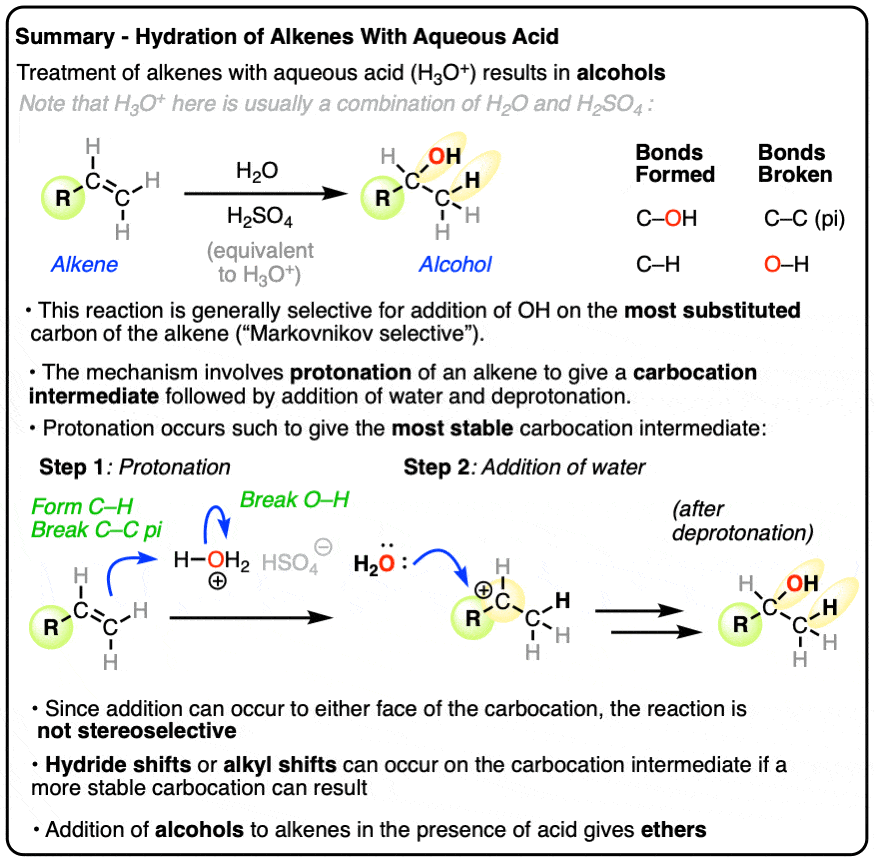
Table of Contents
-
- Hydration of Alkenes With Acid
- Acid-Catalyzed Hydration of Alkenes Has Markovnikov Regioselectivity
- Hydration Is Not Stereoselective
- Mechanism for the Acid-Catalyzed Hydration of Alkenes
- Reaction Energy Diagram
- Carbocation Rearrangements in Hydration
- Addition of Alcohols To Alkenes With Acid
- Intramolecular Reactions of Alkenes and Alcohols
- Summary
- Notes
- Quiz Yourself!
- (Advanced) References and Further Reading
1. Hydration of Alkenes With Acid
When alkenes (olefins) are treated with strong aqueous acid (H3O+) they undergo net addition of water across the double bond (“hydration”). A new C-H bond and and a new C-OH bond are formed, and the C-C pi bond is broken.
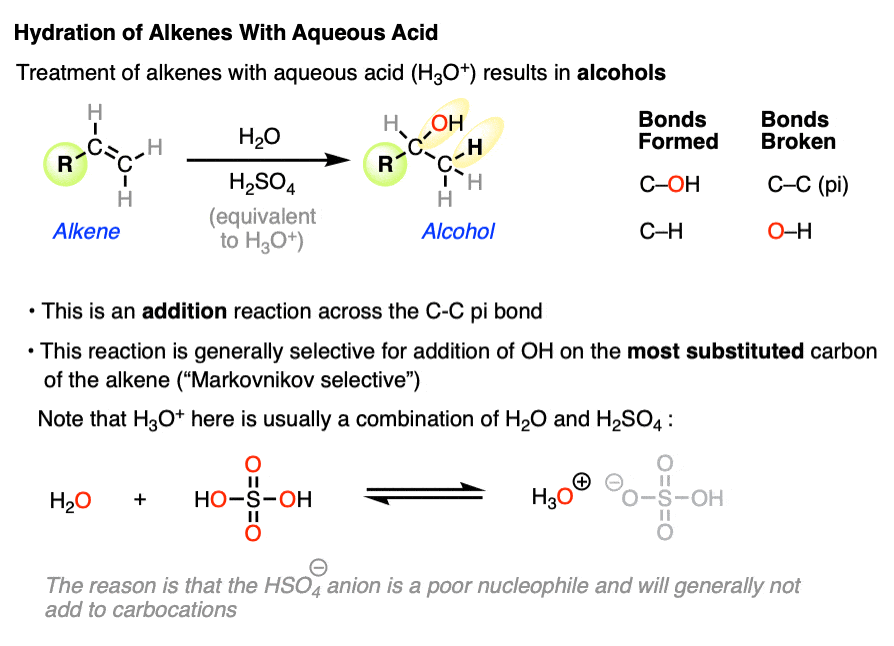
If we add up the bond dissociation energies (BDE’s) of the bonds that form (C-H, about 98 kcal/mol, and C-O about 85 kcal/mol) and subtract their sum from those of the bonds that break (C-C pi, about 63 kcal/mol, and H-O, about 111 kcal/mol) the reaction is exothermic by about 10 kcal/mol for the addition of H2O. [Link to useful table]
H2O will not add to alkenes by itself, however. Strong acid is required. The reagent for this reaction is commonly written as “H3O+” which is often just a combination of water and sulfuric acid. (Acids like H2SO4 are used since the conjugate base, HSO4(-), is a poor nucleophile and will not compete with H2O in attack on the carbocation). [Note 1]
This reaction bears many similarities to the addition of H–X (HCl, HBr, HI) across alkenes in that it is regioselective for formation of the more substituted alcohol (“Markovnikov” selectivity) and also that carbocation rearrangements can occur (See: Rearrangements in Alkene Addition Reactions)
2. Hydration of Alkenes Has “Markovnikov” Regioselectivity
Any time an addition of two different atoms occurs across a double bond there is the possibility of forming constitutional isomers. Hydration of propene, for example, could result in the formation of either 1-propanol or 2-propanol.
A regioselective reaction is one that shows a strong preference for the formation of one constitutional isomer (“regioisomer”) over another.
In the addition of H2O across an alkene catalyzed by acid, the major product results from formation of the C-OH bond on the most substituted carbon of the alkene – that is, the sp2 -hybridized carbon of the alkene directly bonded to the most carbon atoms.
This is known as “Markovnikov” regioselectivity. [See article – Addition of HX to Alkenes and Markovnikov’s Rule]
[Alternatively, you can look at it as the H forms on the carbon containing the most bonds to hydrogen. A useful mnemonic here is “the rich (in C-H bonds) get richer (get another C-H bond)” ].
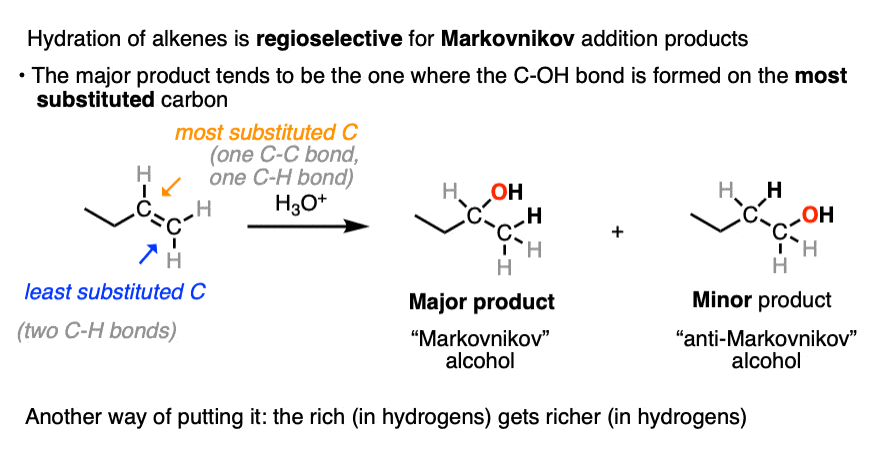
Here are some more examples of the reactions of H3O+ with alkenes. The major product has the C-OH bond form on the more substituted carbon in each case.
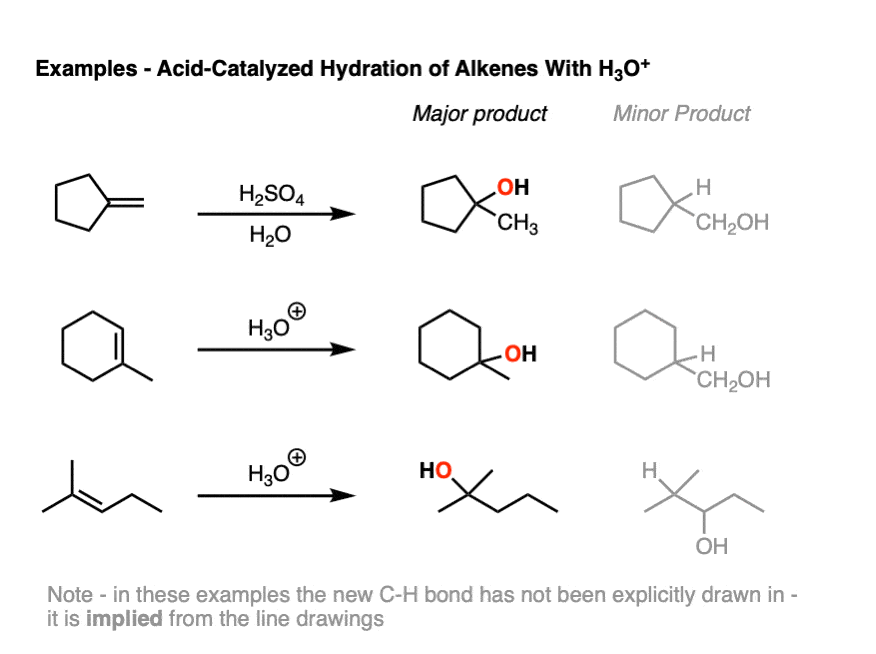
Depending on the structure of the starting alkene, the resulting product(s) may be a mixture of structural isomers, a mixture of enantiomers, diastereromers, or a single achiral product. [For more on this topic, see What’s A Racemic Mixture, or Types of Isomers]
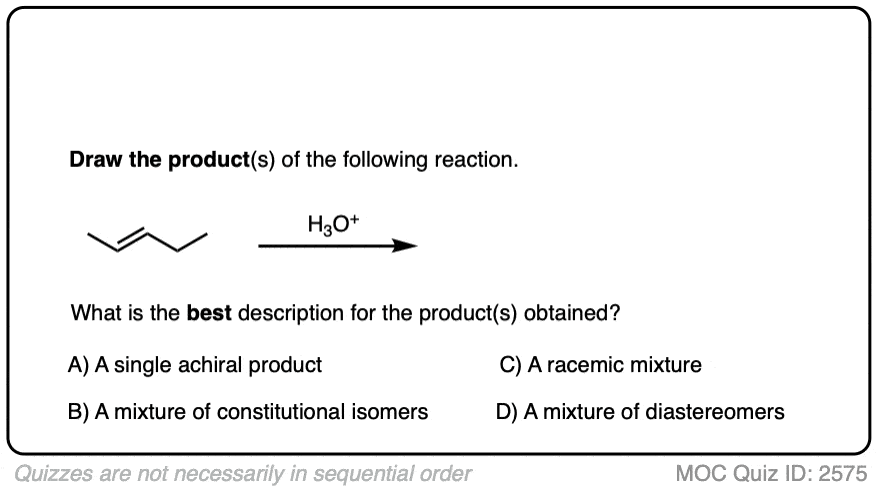 Click to Flip
Click to Flip
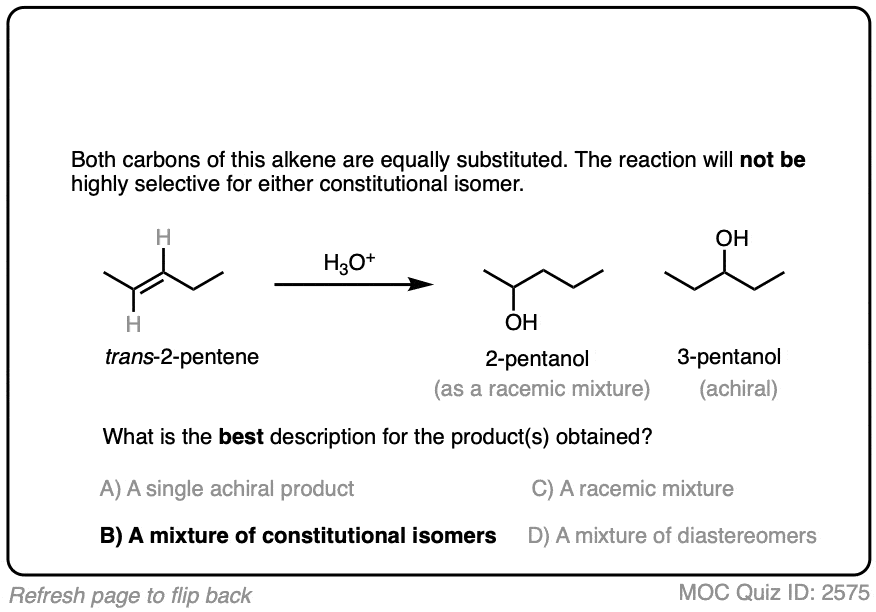
See if you can determine the major product in the reaction below:
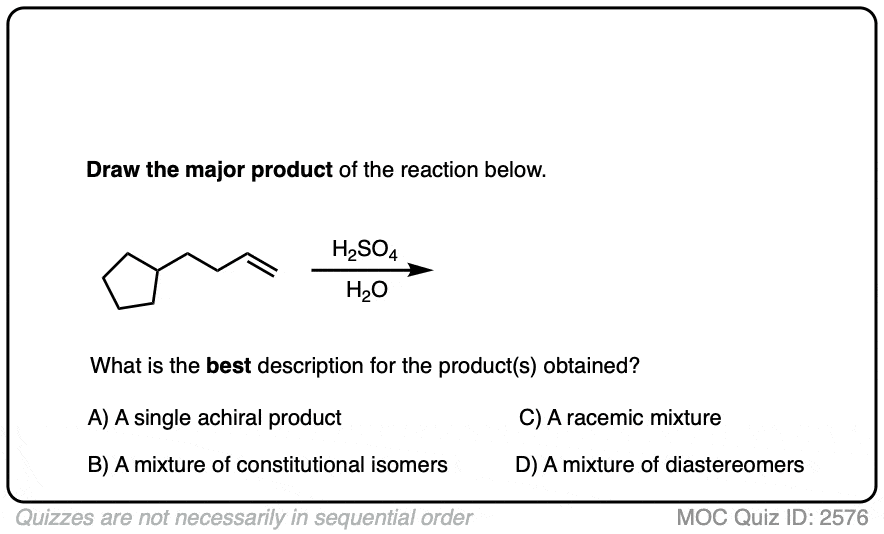 Click to Flip
Click to Flip
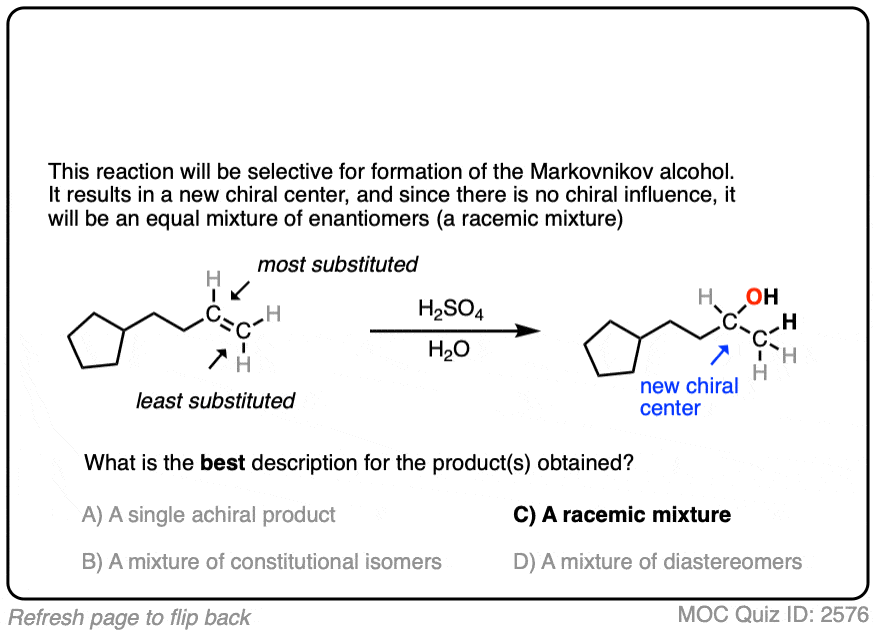
3. Acid-Catalyzed Hydration is Not Stereoselective
The pi bond in alkenes is flat and has two faces.
When addition occurs such that both new bonds to carbon form on the same face of the alkene, we call this syn addition. When the two bonds are formed on opposite faces of the alkene, it is called anti addition.
(“syn”- and “anti” are subtly different from “cis” and “trans” in that they refer to dihedral angle, as opposed to orientation about a double bond or small ring. See Staggered vs. Eclipsed Conformations of Ethane)
Some reactions, like hydroboration, are stereoselective for syn addition products. Others, like bromination of alkenes, are stereoselective for anti addition products. [See posts – Hydroboration of Alkenes, Halogenation of Alkenes]
In contrast, hydration of alkenes is not stereoselective. In the example below, the product where C-OH and C-H have added to the same face of the cyclohexane ring (“syn addition”) is formed in about equal proportion to the product where C-OH and C-H are formed on opposite faces of the cyclohexane ring (“anti addition”). [Reference]
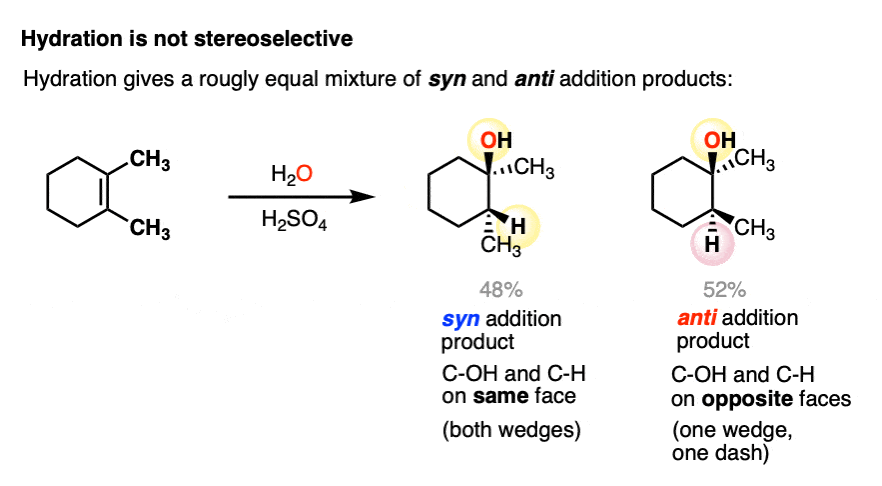
(Note also that in the products above, the syn and anti products are each formed as a racemic mixture of enantiomers.)
See if you can draw the products of the following reaction involving a deuterated alkene.
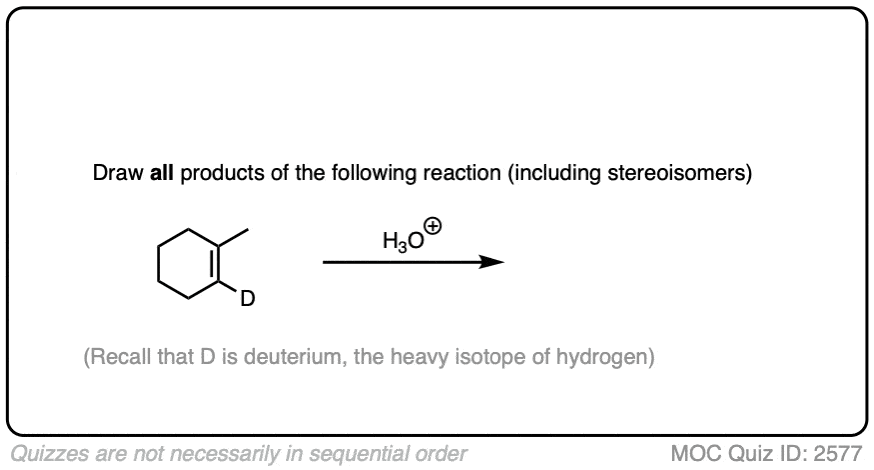 Click to Flip
Click to Flip
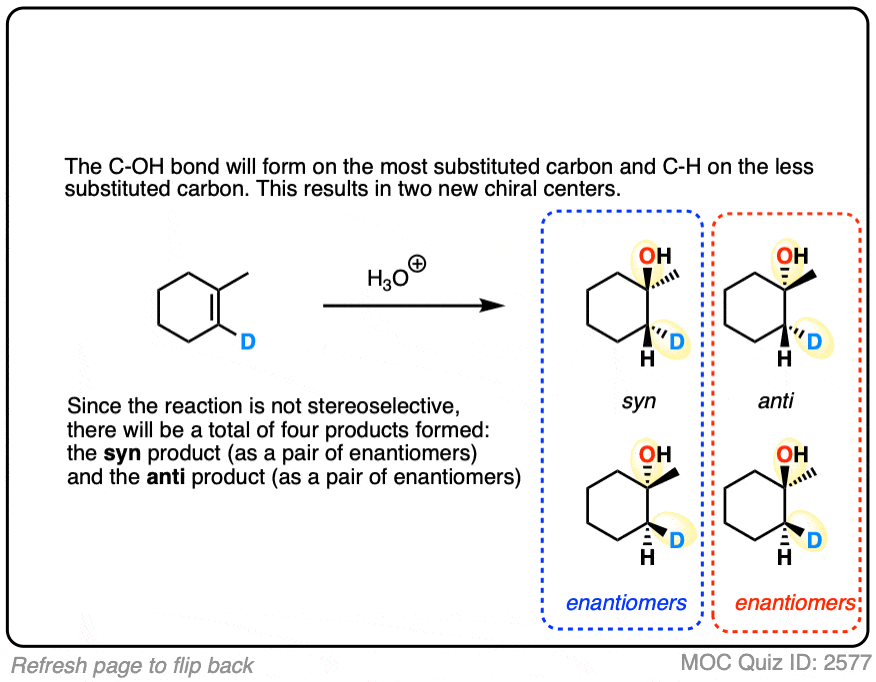
4. Mechanism of Acid-Catalyzed Hydration
So how does this reaction work, anyway?
Well, any mechanism for hydration will have to explain some important observations.
- The high selectivity for Markovnikov products
- The lack of stereoselectivity
- The formation of products that arise from carbocation rearrangements. More on this below [For a full discussion, see Carbocation Rearrangements in Alkene Addition Reactions]
The best mechanistic explanation for this reaction is that it proceeds through a carbocation intermediate, similar to the addition of H-X to alkenes.
In the first step, the alkene is protonated by strong acid, giving a carbocation:
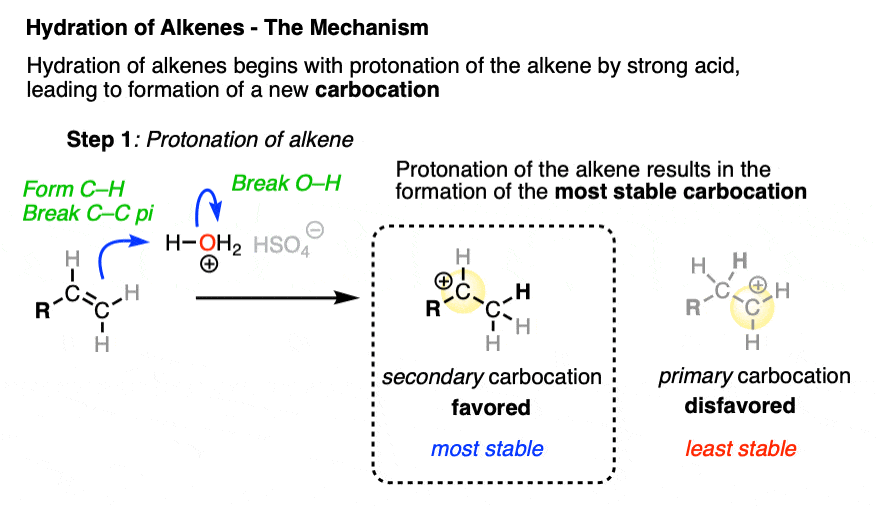
Protonation could potentially occur on either carbon of the alkene, but protonation that results in the most stable carbocation will be favored.
Since carbocations tend to increase in stability as the number of substituents are added, this helps to explain the observed Markovnikov selectivity. (See article: Carbocation Stability)
(More specifically, the reaction will proceed through the lowest-energy transition state, which is the one where the carbon best able to stabilize positive charge will be favored. ]
Carbocations are excellent Lewis acids, having only six valence electrons and an empty p-orbital. They will readily combine with the best nucleophile present in solution.
In this case the best nucleophile is H2O, which adds to the carbocation to give R-OH2(+). (For hydration, sulfuric acid is often used as opposed to hydrohalic acids like H-Cl or H-Br, since the conjugate base HSO4(-) is poor nucleophile and less likely to compete with H2O than Cl(-) or Br(-) )
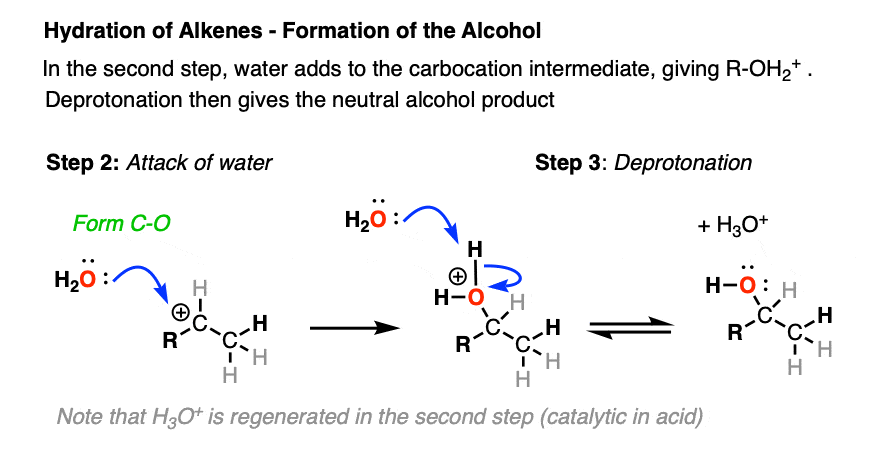
Deprotonation of the oxonium ion by a weak base then gives the neutral alcohol. Note that in this case, H3O+ is regenerated, so acid acts as a catalyst here.
5. The Reaction Energy Diagram For Acid-Catalyzed Hydration
Reaction energy diagrams are helpful for visualizing changes in energy as reactants are transformed into products. Changes in energy (Δ E) are graphed on the y-axis, while reaction progress from reactants to products is graphed on the x-axis.
In a reaction energy diagram, the local maxima (“peaks”) represent transition states which include partial bonds and partial charges and exceptionally brief lifetimes.
Local minima (“valleys”) represent intermediates with full charges and bonds, and can (at least potentially) be observed in solution.
The rate-determining step is the step with the greatest difference in energy (Δ E) between reactants and the transition state.
In hydration, the rate-determining step corresponds to the first step – the protonation of the alkene with strong acid, which then results in the carbocation intermediate. In the second step (transition state #2) water adds to the carbocation, giving the protonated alcohol (oxonium ion) intermediate. This is followed by a third step (transition state #3) – deprotonation to give the neutral alcohol.
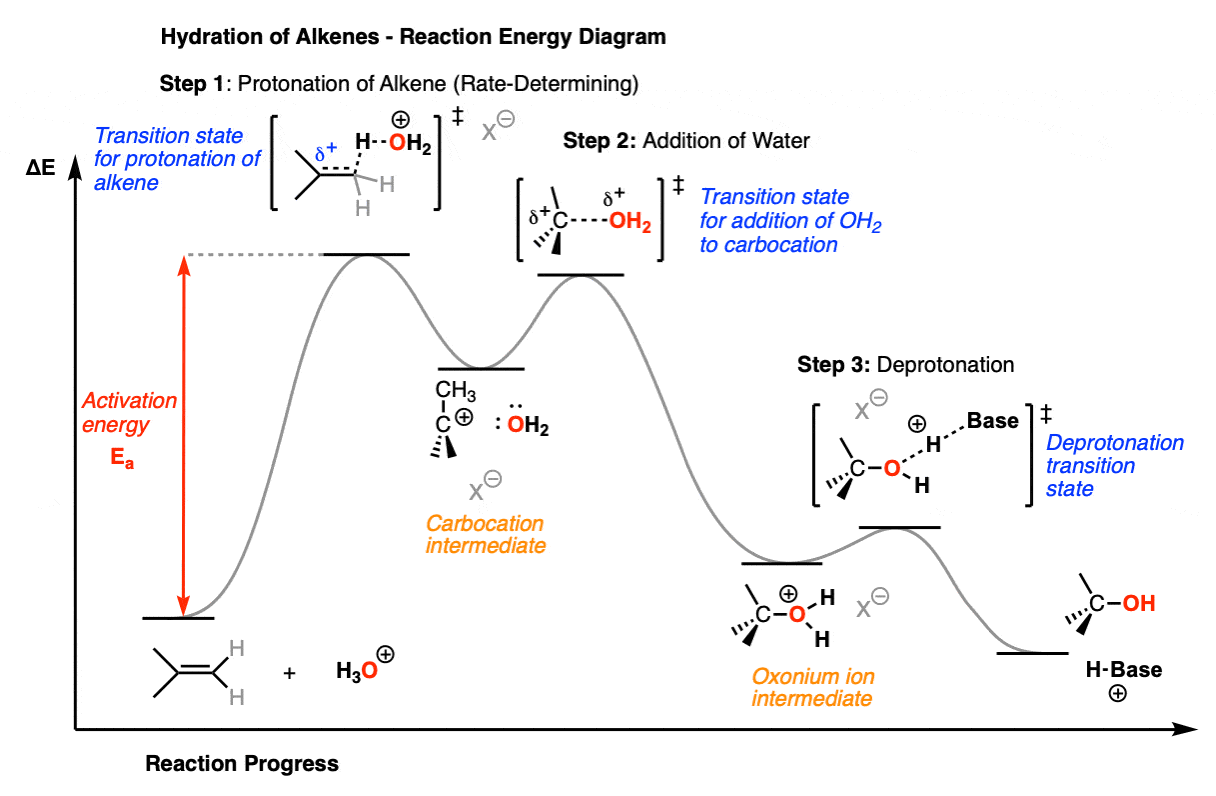
Although not shown in the diagram above, protonation of the alkene to give the less substituted carbocation would proceed through a significantly higher-energy transition state and also result in a significantly higher-energy carbocation intermediate.
6. Carbocation Rearrangements
Hydration of alkenes can be accompanied by rearrangements if a hydride or alkyl shift results in a more stable carbocation. (See, for example – Rearrangement Reactions – Hydride Shifts)
For example, hydration of the alkene below results in a considerable amount of a tertiary alcohol instead of the expected secondary alcohol product that would result from a simple Markovnikov addition.
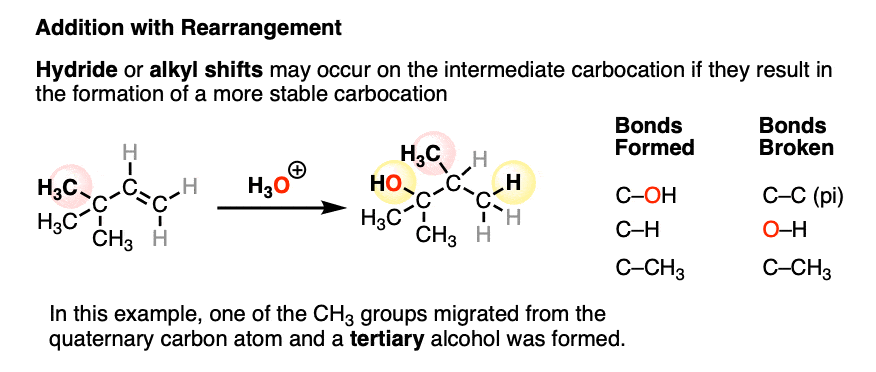
Why is that? See if you can draw the mechanism of the reaction that leads to this product:
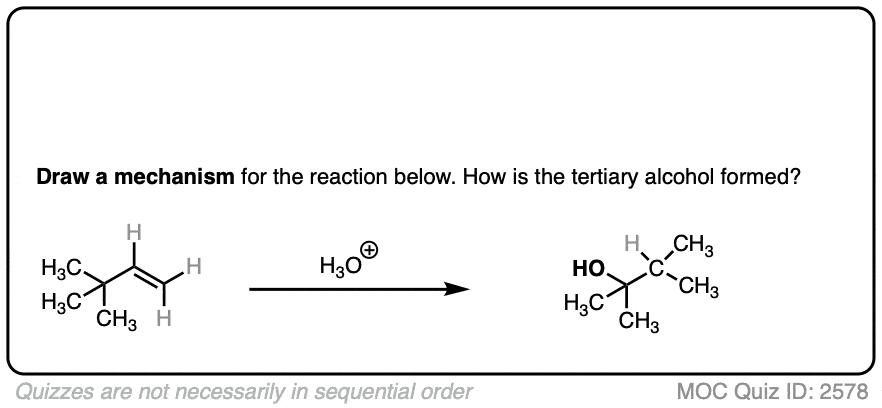 Click to Flip
Click to Flip
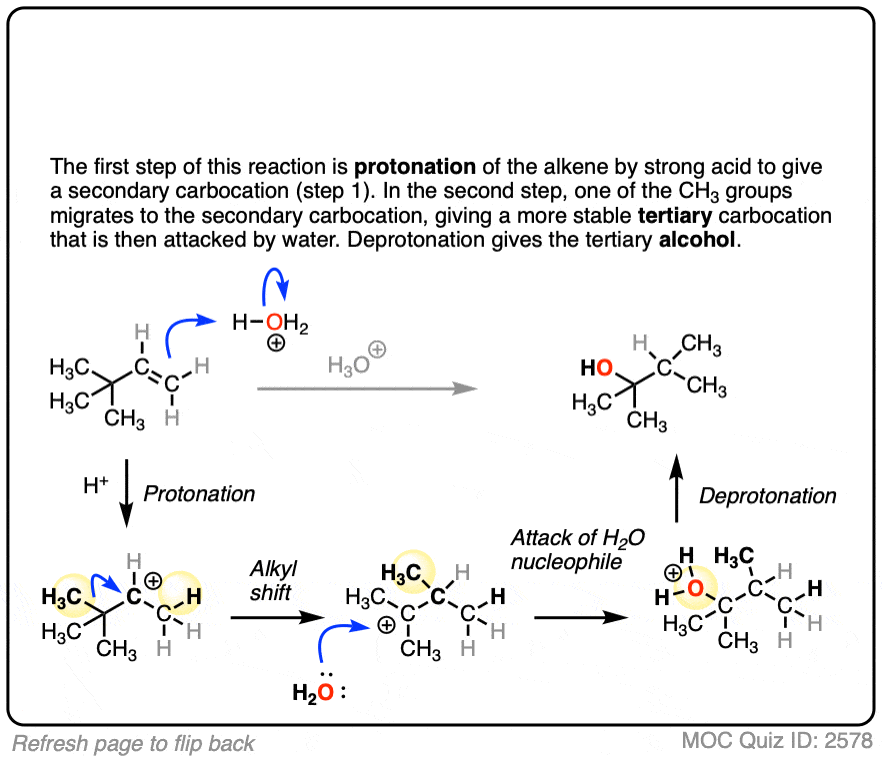
In this case, a more stable tertiary carbocation is generated after migration of the CH3 group on the adjacent carbon.
Note that if one wants to avoid carbocation rearrangements in the formation of alcohols with Markovnikov selectivity, a good strategy is to use oxymercuration-demercuration instead. (See article: Oxymercuration Demercuration of Alkenes)
For more examples of rearrangement quizzes, see the “Quiz Yourself” section below.
7. Addition of Alcohols To Alkenes With Acid
If an alcohol is used in place of water, subsequent treatment of alkenes with an acid catalyst can result in ethers.
The reaction is essentially the same as that for the reaction with H2O. Protonation results in the most stable carbocation, which is then attacked by the alcohol. Deprotonation then gives the ether.
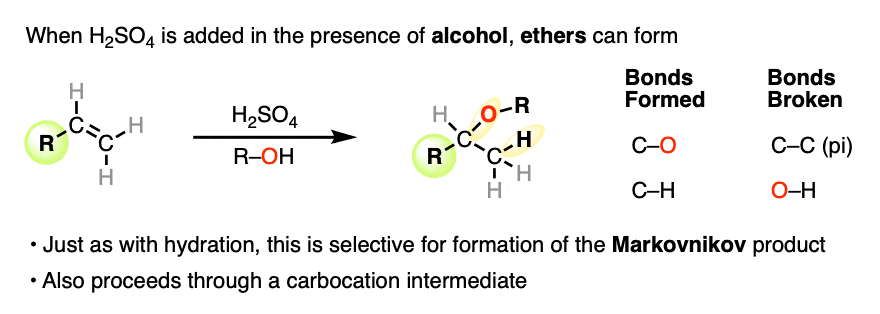
See if you can draw the product in the reaction below:
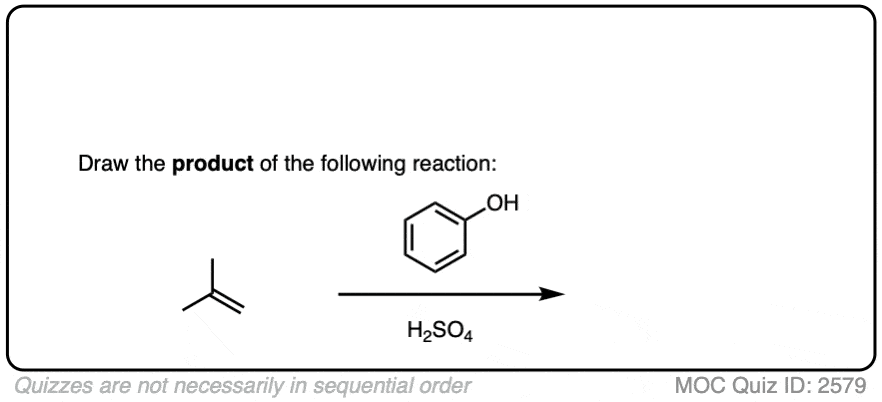 Click to Flip
Click to Flip
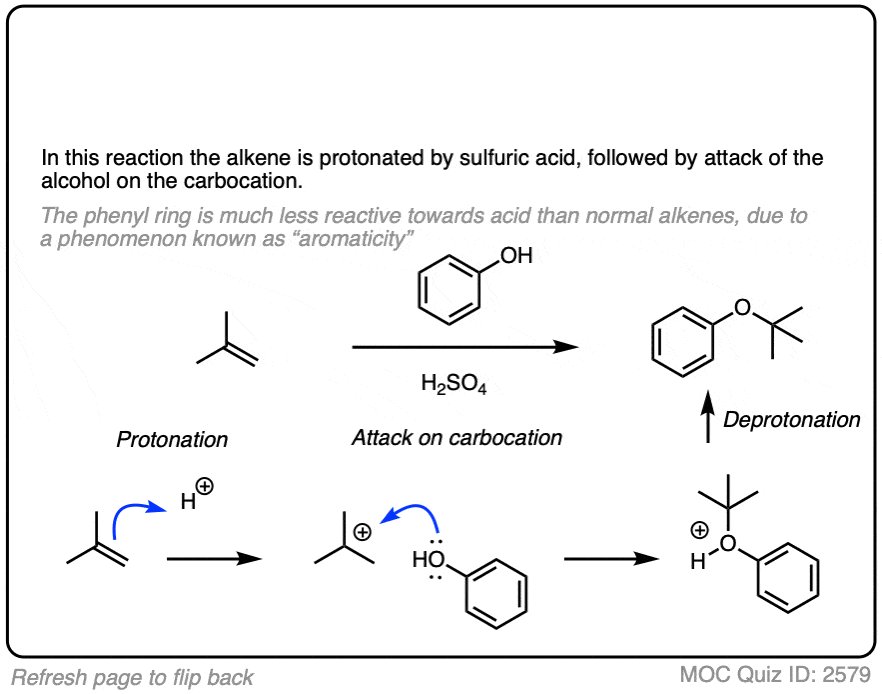
This reaction can come in handy for making ethers that are otherwise difficult to make through, say, an SN2 reaction between an alkoxide and an alkyl halide. [Note 2]
Much later, in the chapter on reactions of aromatic compounds, we’ll see examples of using t-butyl ethers as temporary protecting groups for aromatic alcohols – see this article on Blocking Groups.
8. Intramolecular Reactions of Alcohols and Alkenes
If an alcohol and an alkene are present on the same molecule, then treatment with acid can result in the intramolecular formation of an ether, resulting in a new ring.
It works best for the formation of 5- and 6-membered rings, as these rings are formed fastest and also have the least ring strain.
See if you can draw the mechanism of this reaction:
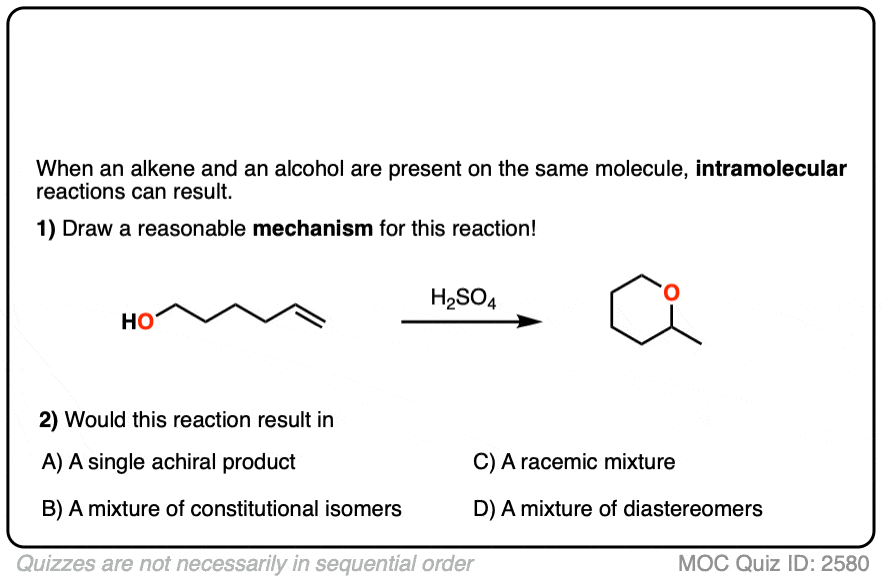 Click to Flip
Click to Flip
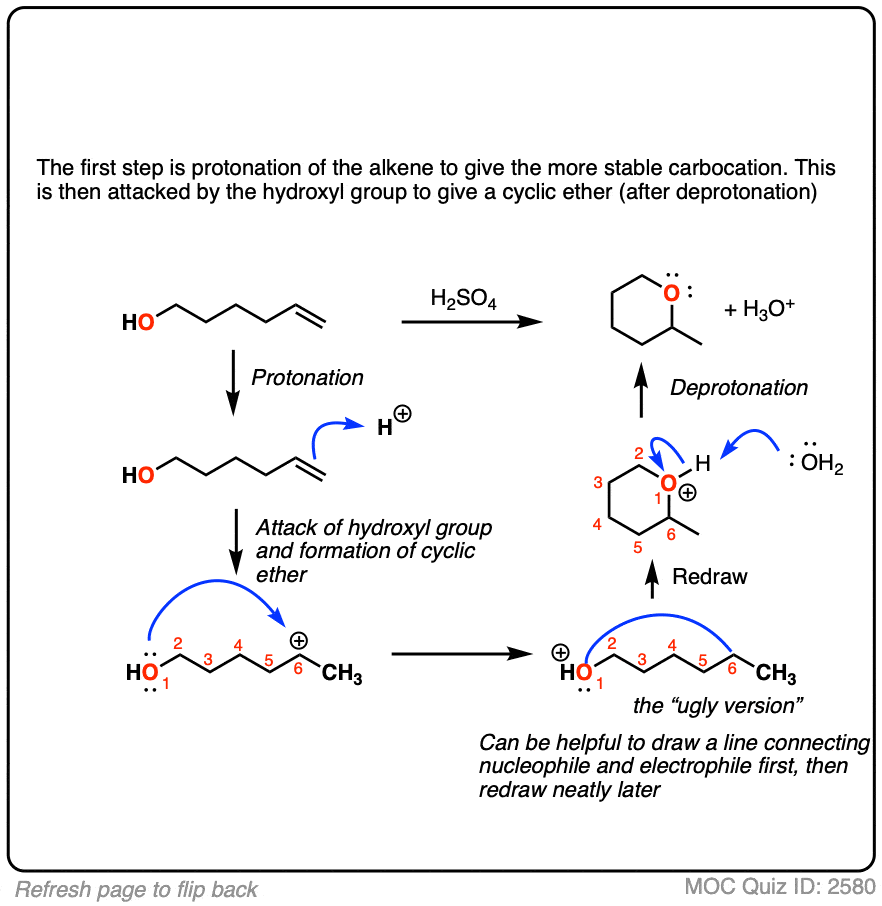
Watch out for these kinds of examples, as they are commonly found on exams!
9. Summary
Hydration of alkenes and the addition of alcohols to alkenes are two examples of reactions that pass through what I sometimes call the “carbocation pathway” of alkene addition reactions.These reactions, along with addition of H-X to alkenes, all have the following in common.
- They pass through an intermediate carbocation and are selective for Markovnikov products
- They give a mixture of syn and anti– addition products (i.e. are not stereoselective)
- Carbocation rearrangements may occur.
For more, (See article – Alkene Addition Pattern #1 – The Carbocation Pathway)
Notes
Related Articles
- Markovnikov Addition Of HCl To Alkenes
- Oxymercuration Demercuration of Alkenes
- Rearrangements in Alkene Addition Reactions
- Hydroboration Oxidation of Alkenes
- Addition Pattern #1: The “Carbocation Pathway”
- Rearrangement Reactions (1) – Hydride Shifts
- Halogenation of Alkenes and Halohydrin Formation
- The Williamson Ether Synthesis
- Aromatic Synthesis (3) – Sulfonyl Blocking Groups
- What’s a Racemic Mixture?
- Alkene Addition Reactions: “Regioselectivity” and “Stereoselectivity” (Syn/Anti)
Note 1. Even if HSO4(-) does add to the carbocation to give an alkyl sulfate, these are quite readily hydrolyzed in water to give alcohols.
Note 2. Although it should be noted that adding acid to alcohols also invites the possibility of elimination reactions to give alkenes! For our purposes, something like oxymercuration is probably a better choice for making ethers from alkenes, since it is not accompanied by elimination.
Quiz Yourself!
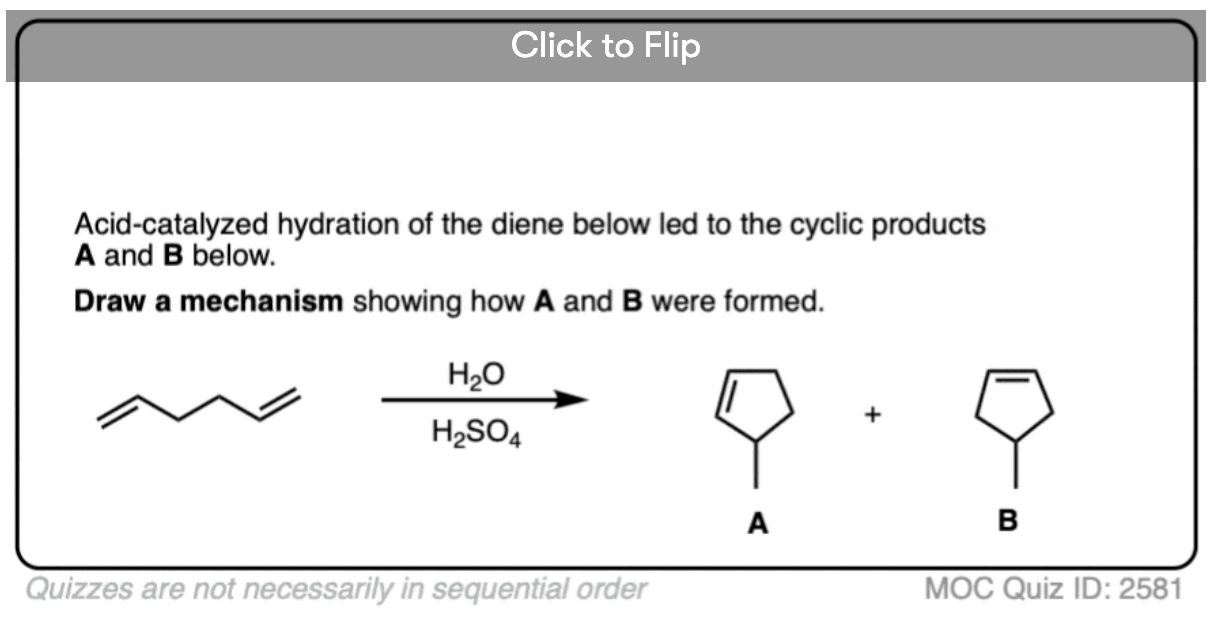
Become a MOC member to see the clickable quiz with answers on the back.
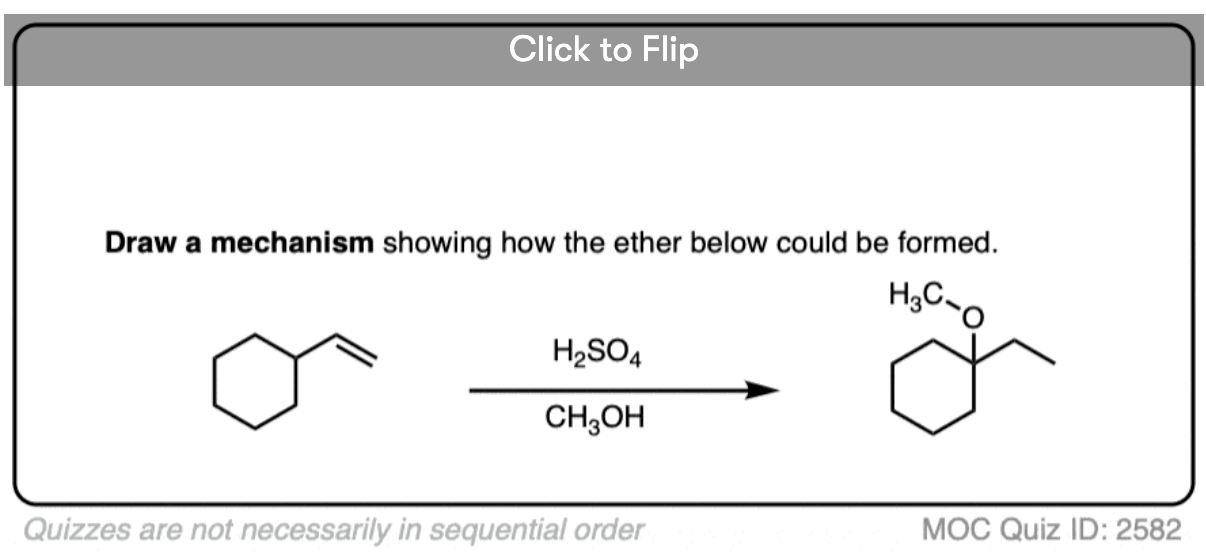
Become a MOC member to see the clickable quiz with answers on the back.
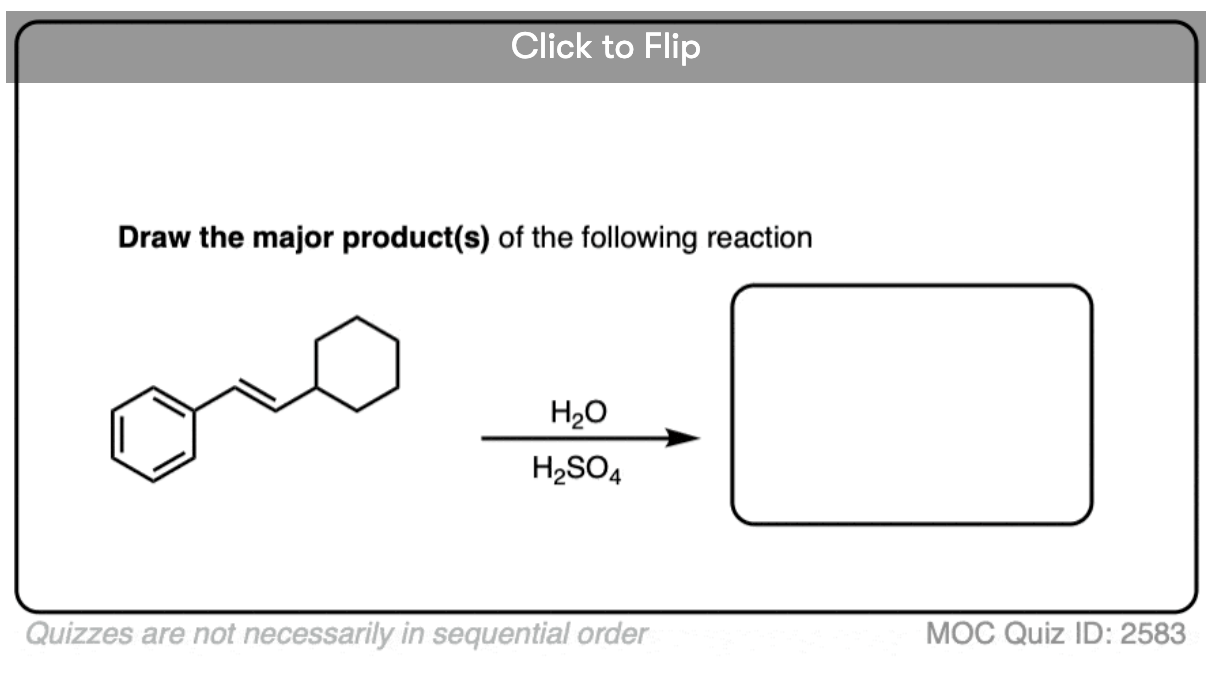
Become a MOC member to see the clickable quiz with answers on the back.
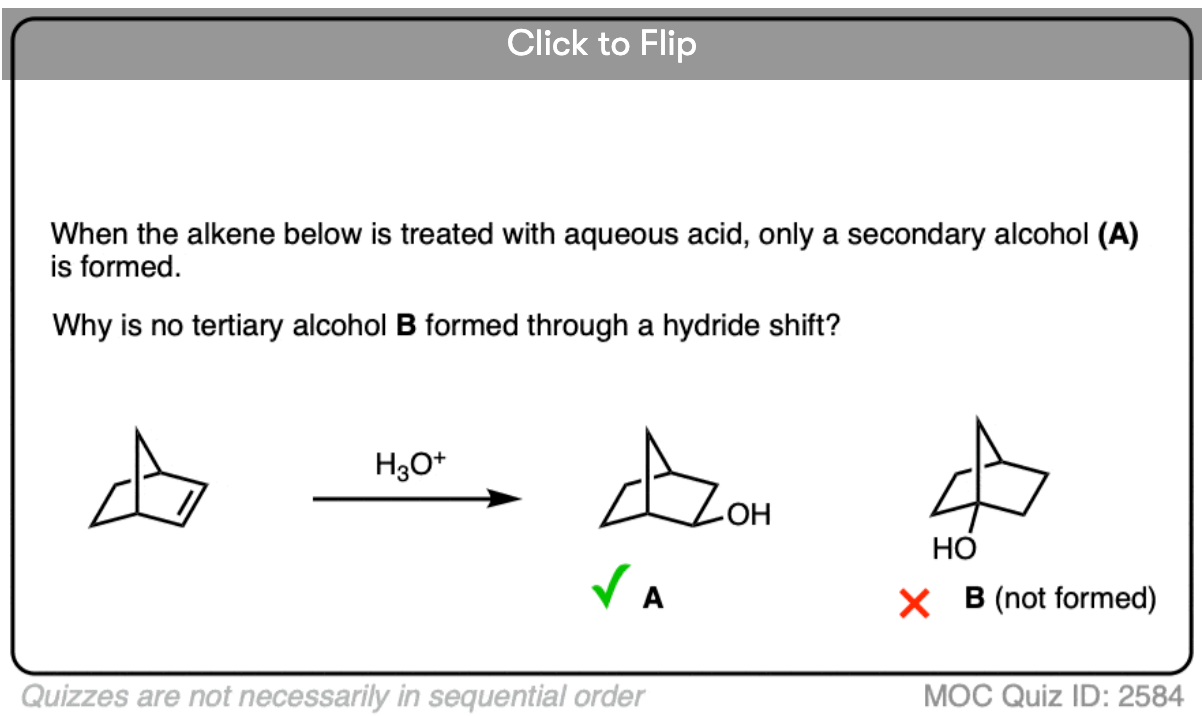
Become a MOC member to see the clickable quiz with answers on the back.
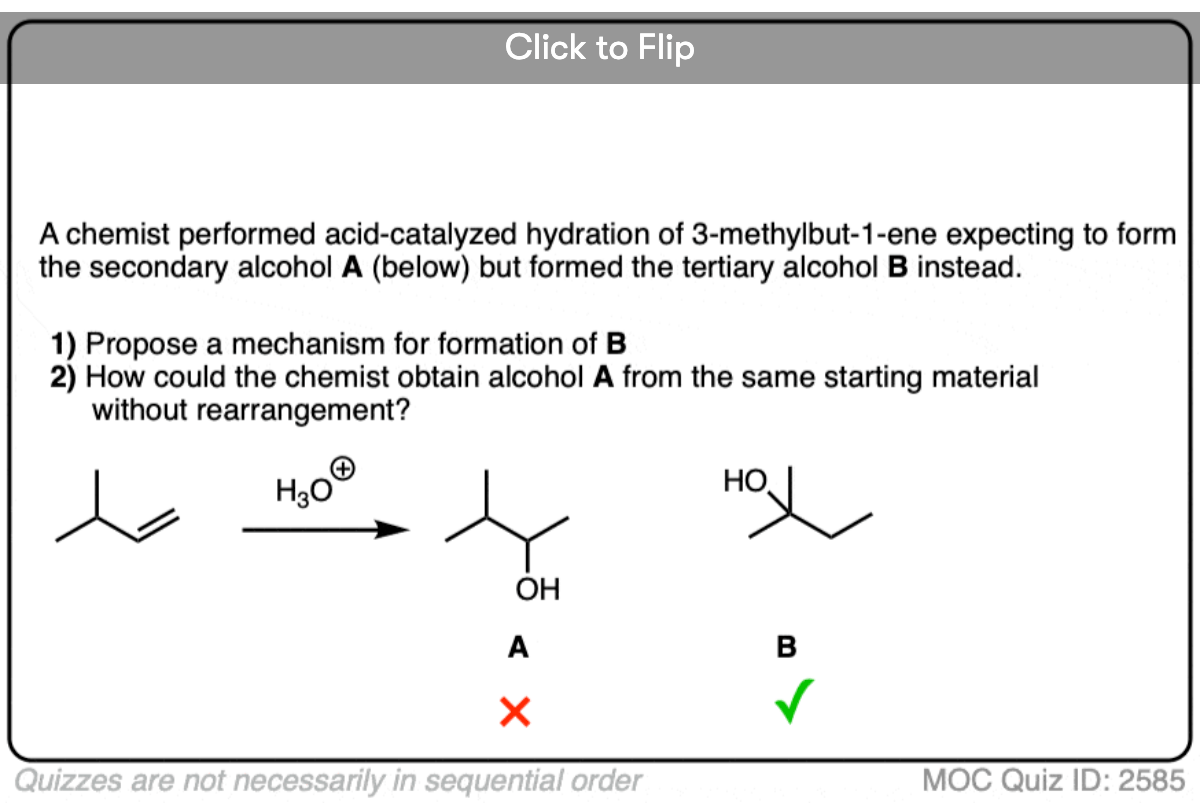
Become a MOC member to see the clickable quiz with answers on the back.
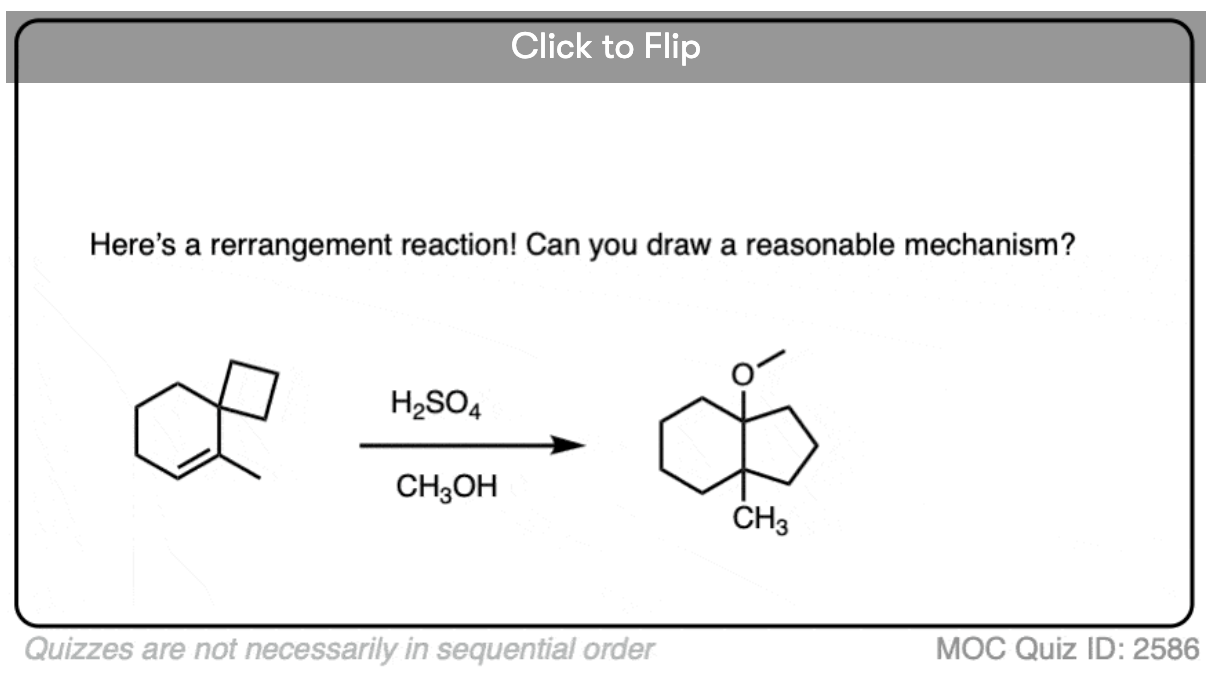
Become a MOC member to see the clickable quiz with answers on the back.
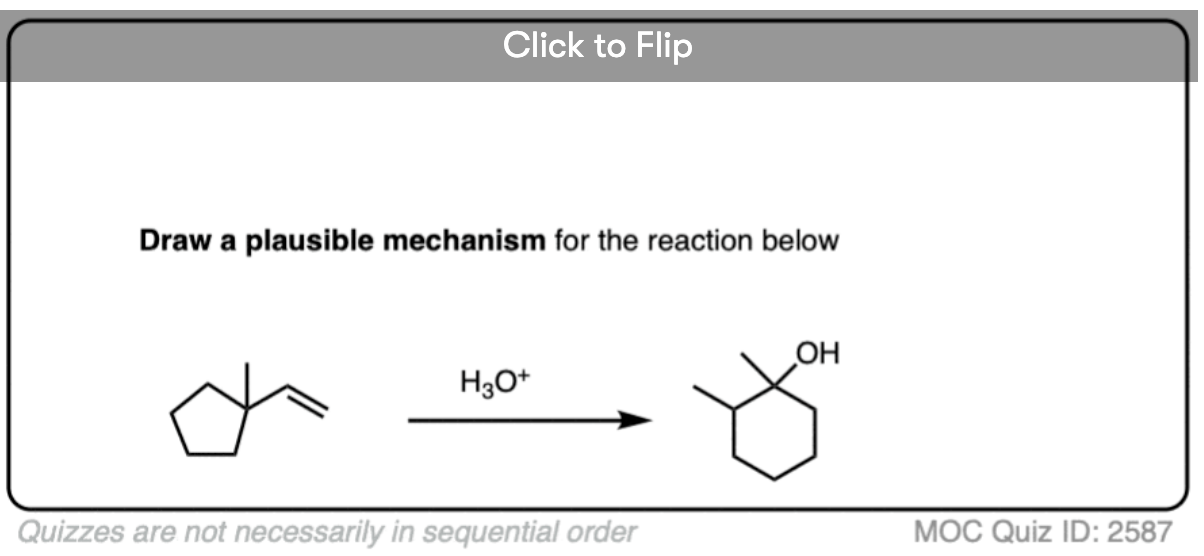
Become a MOC member to see the clickable quiz with answers on the back.
(Advanced) References and Further Reading
- The Electrolyte Effects in the Hydration of Isobutene
Frank G. Ciapetta and Martin Kilpatrick
Journal of the American Chemical Society 1948, 70 (2), 639-646
DOI: 10.1021/ja01182a062
An early paper on the acid-catalyzed hydration of alkenes. - The Dependence of the Rate of Hydration of Isobutene on the Acidity Function, H0, and the Mechanism for Olefin Hydration in Aqueous Acids
Robert W. Taft Jr.
Journal of the American Chemical Society 1952, 74 (21), 5372-5376
DOI: 10.1021/ja01141a046
This early paper demonstrates that the rate of olefin hydration increases with the acidity of the medium, providing evidence that a carbocation is the intermediate in the reaction – these become increasingly stable as the acidity of the medium increases. - The Steric Course of Hydration of 1,2-Dimethylcyclohexene
CAROL H. COLLINS and GEORGE S. HAMMOND
The Journal of Organic Chemistry 1960 25 (6), 911-913
DOI: 10.1021/jo01076a009
In this study, 1,2-dimethylcyclohexene was treated with 0.1 M nitric acid for 1 day at 50°C and a 52:48 ratio of trans to cis alcohols was obtained, showing the reaction is not stereoselective. - General acid catalysis in the hydration of simple olefins. Mechanism of olefin hydration
A. J. Kresge, Y. Chiang, P. H. Fitzgerald, R. S. McDonald, and G. H. Schmid
Journal of the American Chemical Society 1971, 93 (19), 4907-4908
DOI: 10.1021/ja00748a043
The key finding of this paper is that 2,3-dimethyl-2-butene and trans-cyclooctene undergo hydration with general acid catalysis and therefore other alkenes do as well (i.e. direct protonation of the alkene with no intermediate pi complex). - Structural effects on the acid-catalyzed hydration of alkenes
Vincent J. Nowlan and Thomas T. Tidwell
Accounts of Chemical Research 1977, 10 (7), 252-258
DOI: 10.1021/ar50115a004
This is a useful account that reviews all the work done on investigating the acid-catalyzed hydration of alkenes up to that point. It also ties this topic to carbocation chemistry – the 2-norbornyl cation, which was a hot topic at the time, is mentioned towards the end. - Enthalpies of hydration of alkenes. 4. Formation of acyclic tert-alcohols
Kenneth B. Wiberg and Shide Hao
The Journal of Organic Chemistry 1991, 56 (17), 5108-5110
DOI: 10.1021/jo00017a022
A nice calorimetric study on the hydration of alkenes, determining the enthalpy of this reaction. - PREPARATION OF tert-BUTYL ARYL ETHERS
DONALD R. STEVENS
The Journal of Organic Chemistry 1955 20 (9), 1232-1236
DOI: 10.1021/jo01126a010
“tert-alkyl aryl ethers can be prepared in fairly high yields by simply passing isobutylene into the phenol at relatively low temperatures and in the presence of only a trace of sulfuric acid as the catalyst.”
00 General Chemistry Review
01 Bonding, Structure, and Resonance
- How Do We Know Methane (CH4) Is Tetrahedral?
- Hybrid Orbitals and Hybridization
- How To Determine Hybridization: A Shortcut
- Orbital Hybridization And Bond Strengths
- Sigma bonds come in six varieties: Pi bonds come in one
- A Key Skill: How to Calculate Formal Charge
- The Four Intermolecular Forces and How They Affect Boiling Points
- 3 Trends That Affect Boiling Points
- How To Use Electronegativity To Determine Electron Density (and why NOT to trust formal charge)
- Introduction to Resonance
- How To Use Curved Arrows To Interchange Resonance Forms
- Evaluating Resonance Forms (1) - The Rule of Least Charges
- How To Find The Best Resonance Structure By Applying Electronegativity
- Evaluating Resonance Structures With Negative Charges
- Evaluating Resonance Structures With Positive Charge
- Exploring Resonance: Pi-Donation
- Exploring Resonance: Pi-acceptors
- In Summary: Evaluating Resonance Structures
- Drawing Resonance Structures: 3 Common Mistakes To Avoid
- How to apply electronegativity and resonance to understand reactivity
- Bond Hybridization Practice
- Structure and Bonding Practice Quizzes
- Resonance Structures Practice
02 Acid Base Reactions
- Introduction to Acid-Base Reactions
- Acid Base Reactions In Organic Chemistry
- The Stronger The Acid, The Weaker The Conjugate Base
- Walkthrough of Acid-Base Reactions (3) - Acidity Trends
- Five Key Factors That Influence Acidity
- Acid-Base Reactions: Introducing Ka and pKa
- How to Use a pKa Table
- The pKa Table Is Your Friend
- A Handy Rule of Thumb for Acid-Base Reactions
- Acid Base Reactions Are Fast
- pKa Values Span 60 Orders Of Magnitude
- How Protonation and Deprotonation Affect Reactivity
- Acid Base Practice Problems
03 Alkanes and Nomenclature
- Meet the (Most Important) Functional Groups
- Condensed Formulas: Deciphering What the Brackets Mean
- Hidden Hydrogens, Hidden Lone Pairs, Hidden Counterions
- Don't Be Futyl, Learn The Butyls
- Primary, Secondary, Tertiary, Quaternary In Organic Chemistry
- Branching, and Its Affect On Melting and Boiling Points
- The Many, Many Ways of Drawing Butane
- Wedge And Dash Convention For Tetrahedral Carbon
- Common Mistakes in Organic Chemistry: Pentavalent Carbon
- Table of Functional Group Priorities for Nomenclature
- Summary Sheet - Alkane Nomenclature
- Organic Chemistry IUPAC Nomenclature Demystified With A Simple Puzzle Piece Approach
- Boiling Point Quizzes
- Organic Chemistry Nomenclature Quizzes
04 Conformations and Cycloalkanes
- Staggered vs Eclipsed Conformations of Ethane
- Conformational Isomers of Propane
- Newman Projection of Butane (and Gauche Conformation)
- Introduction to Cycloalkanes
- Geometric Isomers In Small Rings: Cis And Trans Cycloalkanes
- Calculation of Ring Strain In Cycloalkanes
- Cycloalkanes - Ring Strain In Cyclopropane And Cyclobutane
- Cyclohexane Conformations
- Cyclohexane Chair Conformation: An Aerial Tour
- How To Draw The Cyclohexane Chair Conformation
- The Cyclohexane Chair Flip
- The Cyclohexane Chair Flip - Energy Diagram
- Substituted Cyclohexanes - Axial vs Equatorial
- Ranking The Bulkiness Of Substituents On Cyclohexanes: "A-Values"
- Cyclohexane Chair Conformation Stability: Which One Is Lower Energy?
- Fused Rings - Cis-Decalin and Trans-Decalin
- Naming Bicyclic Compounds - Fused, Bridged, and Spiro
- Bredt's Rule (And Summary of Cycloalkanes)
- Newman Projection Practice
- Cycloalkanes Practice Problems
05 A Primer On Organic Reactions
- The Most Important Question To Ask When Learning a New Reaction
- Curved Arrows (for reactions)
- Nucleophiles and Electrophiles
- The Three Classes of Nucleophiles
- Nucleophilicity vs. Basicity
- What Makes A Good Nucleophile?
- What Makes A Good Leaving Group?
- 3 Factors That Stabilize Carbocations
- Equilibrium and Energy Relationships
- 7 Factors that stabilize negative charge in organic chemistry
- 7 Factors That Stabilize Positive Charge in Organic Chemistry
- What's a Transition State?
- Hammond's Postulate
- Learning Organic Chemistry Reactions: A Checklist (PDF)
- Introduction to Oxidative Cleavage Reactions
06 Free Radical Reactions
- Free Radical Reactions
- 3 Factors That Stabilize Free Radicals
- Bond Strengths And Radical Stability
- Free Radical Initiation: Why Is "Light" Or "Heat" Required?
- Initiation, Propagation, Termination
- Monochlorination Products Of Propane, Pentane, And Other Alkanes
- Selectivity In Free Radical Reactions
- Selectivity in Free Radical Reactions: Bromination vs. Chlorination
- Halogenation At Tiffany's
- Allylic Bromination
- Bonus Topic: Allylic Rearrangements
- In Summary: Free Radicals
- Synthesis (2) - Reactions of Alkanes
- Free Radicals Practice Quizzes
07 Stereochemistry and Chirality
- Types of Isomers: Constitutional Isomers, Stereoisomers, Enantiomers, and Diastereomers
- How To Draw The Enantiomer Of A Chiral Molecule
- How To Draw A Bond Rotation
- Introduction to Assigning (R) and (S): The Cahn-Ingold-Prelog Rules
- Assigning Cahn-Ingold-Prelog (CIP) Priorities (2) - The Method of Dots
- Enantiomers vs Diastereomers vs The Same? Two Methods For Solving Problems
- Assigning R/S To Newman Projections (And Converting Newman To Line Diagrams)
- How To Determine R and S Configurations On A Fischer Projection
- The Meso Trap
- Optical Rotation, Optical Activity, and Specific Rotation
- Optical Purity and Enantiomeric Excess
- What's a Racemic Mixture?
- Chiral Allenes And Chiral Axes
- Stereochemistry Practice Problems and Quizzes
08 Substitution Reactions
- Nucleophilic Substitution Reactions - Introduction
- Two Types of Nucleophilic Substitution Reactions
- The SN2 Mechanism
- Why the SN2 Reaction Is Powerful
- The SN1 Mechanism
- The Conjugate Acid Is A Better Leaving Group
- Comparing the SN1 and SN2 Reactions
- Polar Protic? Polar Aprotic? Nonpolar? All About Solvents
- Steric Hindrance is Like a Fat Goalie
- Common Blind Spot: Intramolecular Reactions
- Substitution Practice - SN1
- Substitution Practice - SN2
09 Elimination Reactions
- Elimination Reactions (1): Introduction And The Key Pattern
- Elimination Reactions (2): The Zaitsev Rule
- Elimination Reactions Are Favored By Heat
- Two Elimination Reaction Patterns
- The E1 Reaction
- The E2 Mechanism
- E1 vs E2: Comparing the E1 and E2 Reactions
- Antiperiplanar Relationships: The E2 Reaction and Cyclohexane Rings
- Bulky Bases in Elimination Reactions
- Comparing the E1 vs SN1 Reactions
- Elimination (E1) Reactions With Rearrangements
- E1cB - Elimination (Unimolecular) Conjugate Base
- Elimination (E1) Practice Problems And Solutions
- Elimination (E2) Practice Problems and Solutions
10 Rearrangements
11 SN1/SN2/E1/E2 Decision
- Identifying Where Substitution and Elimination Reactions Happen
- Deciding SN1/SN2/E1/E2 (1) - The Substrate
- Deciding SN1/SN2/E1/E2 (2) - The Nucleophile/Base
- SN1 vs E1 and SN2 vs E2 : The Temperature
- Deciding SN1/SN2/E1/E2 - The Solvent
- Wrapup: The Key Factors For Determining SN1/SN2/E1/E2
- Alkyl Halide Reaction Map And Summary
- SN1 SN2 E1 E2 Practice Problems
12 Alkene Reactions
- E and Z Notation For Alkenes (+ Cis/Trans)
- Alkene Stability
- Alkene Addition Reactions: "Regioselectivity" and "Stereoselectivity" (Syn/Anti)
- Stereoselective and Stereospecific Reactions
- Hydrohalogenation of Alkenes and Markovnikov's Rule
- Hydration of Alkenes With Aqueous Acid
- Rearrangements in Alkene Addition Reactions
- Halogenation of Alkenes and Halohydrin Formation
- Oxymercuration Demercuration of Alkenes
- Hydroboration Oxidation of Alkenes
- m-CPBA (meta-chloroperoxybenzoic acid)
- OsO4 (Osmium Tetroxide) for Dihydroxylation of Alkenes
- Palladium on Carbon (Pd/C) for Catalytic Hydrogenation of Alkenes
- Cyclopropanation of Alkenes
- A Fourth Alkene Addition Pattern - Free Radical Addition
- Alkene Reactions: Ozonolysis
- Summary: Three Key Families Of Alkene Reaction Mechanisms
- Synthesis (4) - Alkene Reaction Map, Including Alkyl Halide Reactions
- Alkene Reactions Practice Problems
13 Alkyne Reactions
- Acetylides from Alkynes, And Substitution Reactions of Acetylides
- Partial Reduction of Alkynes With Lindlar's Catalyst
- Partial Reduction of Alkynes With Na/NH3 To Obtain Trans Alkenes
- Alkyne Hydroboration With "R2BH"
- Hydration and Oxymercuration of Alkynes
- Hydrohalogenation of Alkynes
- Alkyne Halogenation: Bromination and Chlorination of Alkynes
- Oxidation of Alkynes With O3 and KMnO4
- Alkenes To Alkynes Via Halogenation And Elimination Reactions
- Alkynes Are A Blank Canvas
- Synthesis (5) - Reactions of Alkynes
- Alkyne Reactions Practice Problems With Answers
14 Alcohols, Epoxides and Ethers
- Alcohols - Nomenclature and Properties
- Alcohols Can Act As Acids Or Bases (And Why It Matters)
- Alcohols - Acidity and Basicity
- The Williamson Ether Synthesis
- Ethers From Alkenes, Tertiary Alkyl Halides and Alkoxymercuration
- Alcohols To Ethers via Acid Catalysis
- Cleavage Of Ethers With Acid
- Epoxides - The Outlier Of The Ether Family
- Opening of Epoxides With Acid
- Epoxide Ring Opening With Base
- Making Alkyl Halides From Alcohols
- Tosylates And Mesylates
- PBr3 and SOCl2
- Elimination Reactions of Alcohols
- Elimination of Alcohols To Alkenes With POCl3
- Alcohol Oxidation: "Strong" and "Weak" Oxidants
- Demystifying The Mechanisms of Alcohol Oxidations
- Protecting Groups For Alcohols
- Thiols And Thioethers
- Calculating the oxidation state of a carbon
- Oxidation and Reduction in Organic Chemistry
- Oxidation Ladders
- SOCl2 Mechanism For Alcohols To Alkyl Halides: SN2 versus SNi
- Alcohol Reactions Roadmap (PDF)
- Alcohol Reaction Practice Problems
- Epoxide Reaction Quizzes
- Oxidation and Reduction Practice Quizzes
15 Organometallics
- What's An Organometallic?
- Formation of Grignard and Organolithium Reagents
- Organometallics Are Strong Bases
- Reactions of Grignard Reagents
- Protecting Groups In Grignard Reactions
- Synthesis Problems Involving Grignard Reagents
- Grignard Reactions And Synthesis (2)
- Organocuprates (Gilman Reagents): How They're Made
- Gilman Reagents (Organocuprates): What They're Used For
- The Heck, Suzuki, and Olefin Metathesis Reactions (And Why They Don't Belong In Most Introductory Organic Chemistry Courses)
- Reaction Map: Reactions of Organometallics
- Grignard Practice Problems
16 Spectroscopy
- Degrees of Unsaturation (or IHD, Index of Hydrogen Deficiency)
- Conjugation And Color (+ How Bleach Works)
- Introduction To UV-Vis Spectroscopy
- UV-Vis Spectroscopy: Absorbance of Carbonyls
- UV-Vis Spectroscopy: Practice Questions
- Bond Vibrations, Infrared Spectroscopy, and the "Ball and Spring" Model
- Infrared Spectroscopy: A Quick Primer On Interpreting Spectra
- IR Spectroscopy: 4 Practice Problems
- 1H NMR: How Many Signals?
- Homotopic, Enantiotopic, Diastereotopic
- Diastereotopic Protons in 1H NMR Spectroscopy: Examples
- 13-C NMR - How Many Signals
- Liquid Gold: Pheromones In Doe Urine
- Natural Product Isolation (1) - Extraction
- Natural Product Isolation (2) - Purification Techniques, An Overview
- Structure Determination Case Study: Deer Tarsal Gland Pheromone
17 Dienes and MO Theory
- What To Expect In Organic Chemistry 2
- Are these molecules conjugated?
- Conjugation And Resonance In Organic Chemistry
- Bonding And Antibonding Pi Orbitals
- Molecular Orbitals of The Allyl Cation, Allyl Radical, and Allyl Anion
- Pi Molecular Orbitals of Butadiene
- Reactions of Dienes: 1,2 and 1,4 Addition
- Thermodynamic and Kinetic Products
- More On 1,2 and 1,4 Additions To Dienes
- s-cis and s-trans
- The Diels-Alder Reaction
- Cyclic Dienes and Dienophiles in the Diels-Alder Reaction
- Stereochemistry of the Diels-Alder Reaction
- Exo vs Endo Products In The Diels Alder: How To Tell Them Apart
- HOMO and LUMO In the Diels Alder Reaction
- Why Are Endo vs Exo Products Favored in the Diels-Alder Reaction?
- Diels-Alder Reaction: Kinetic and Thermodynamic Control
- The Retro Diels-Alder Reaction
- The Intramolecular Diels Alder Reaction
- Regiochemistry In The Diels-Alder Reaction
- The Cope and Claisen Rearrangements
- Electrocyclic Reactions
- Electrocyclic Ring Opening And Closure (2) - Six (or Eight) Pi Electrons
- Diels Alder Practice Problems
- Molecular Orbital Theory Practice
18 Aromaticity
- Introduction To Aromaticity
- Rules For Aromaticity
- Huckel's Rule: What Does 4n+2 Mean?
- Aromatic, Non-Aromatic, or Antiaromatic? Some Practice Problems
- Antiaromatic Compounds and Antiaromaticity
- The Pi Molecular Orbitals of Benzene
- The Pi Molecular Orbitals of Cyclobutadiene
- Frost Circles
- Aromaticity Practice Quizzes
19 Reactions of Aromatic Molecules
- Electrophilic Aromatic Substitution: Introduction
- Activating and Deactivating Groups In Electrophilic Aromatic Substitution
- Electrophilic Aromatic Substitution - The Mechanism
- Ortho-, Para- and Meta- Directors in Electrophilic Aromatic Substitution
- Understanding Ortho, Para, and Meta Directors
- Why are halogens ortho- para- directors?
- Disubstituted Benzenes: The Strongest Electron-Donor "Wins"
- Electrophilic Aromatic Substitutions (1) - Halogenation of Benzene
- Electrophilic Aromatic Substitutions (2) - Nitration and Sulfonation
- EAS Reactions (3) - Friedel-Crafts Acylation and Friedel-Crafts Alkylation
- Intramolecular Friedel-Crafts Reactions
- Nucleophilic Aromatic Substitution (NAS)
- Nucleophilic Aromatic Substitution (2) - The Benzyne Mechanism
- Reactions on the "Benzylic" Carbon: Bromination And Oxidation
- The Wolff-Kishner, Clemmensen, And Other Carbonyl Reductions
- More Reactions on the Aromatic Sidechain: Reduction of Nitro Groups and the Baeyer Villiger
- Aromatic Synthesis (1) - "Order Of Operations"
- Synthesis of Benzene Derivatives (2) - Polarity Reversal
- Aromatic Synthesis (3) - Sulfonyl Blocking Groups
- Birch Reduction
- Synthesis (7): Reaction Map of Benzene and Related Aromatic Compounds
- Aromatic Reactions and Synthesis Practice
- Electrophilic Aromatic Substitution Practice Problems
20 Aldehydes and Ketones
- What's The Alpha Carbon In Carbonyl Compounds?
- Nucleophilic Addition To Carbonyls
- Aldehydes and Ketones: 14 Reactions With The Same Mechanism
- Sodium Borohydride (NaBH4) Reduction of Aldehydes and Ketones
- Grignard Reagents For Addition To Aldehydes and Ketones
- Wittig Reaction
- Hydrates, Hemiacetals, and Acetals
- Imines - Properties, Formation, Reactions, and Mechanisms
- All About Enamines
- Breaking Down Carbonyl Reaction Mechanisms: Reactions of Anionic Nucleophiles (Part 2)
- Aldehydes Ketones Reaction Practice
21 Carboxylic Acid Derivatives
- Nucleophilic Acyl Substitution (With Negatively Charged Nucleophiles)
- Addition-Elimination Mechanisms With Neutral Nucleophiles (Including Acid Catalysis)
- Basic Hydrolysis of Esters - Saponification
- Transesterification
- Proton Transfer
- Fischer Esterification - Carboxylic Acid to Ester Under Acidic Conditions
- Lithium Aluminum Hydride (LiAlH4) For Reduction of Carboxylic Acid Derivatives
- LiAlH[Ot-Bu]3 For The Reduction of Acid Halides To Aldehydes
- Di-isobutyl Aluminum Hydride (DIBAL) For The Partial Reduction of Esters and Nitriles
- Amide Hydrolysis
- Thionyl Chloride (SOCl2) And Conversion of Carboxylic Acids to Acid Halides
- Diazomethane (CH2N2)
- Carbonyl Chemistry: Learn Six Mechanisms For the Price Of One
- Making Music With Mechanisms (PADPED)
- Carboxylic Acid Derivatives Practice Questions
22 Enols and Enolates
- Keto-Enol Tautomerism
- Enolates - Formation, Stability, and Simple Reactions
- Kinetic Versus Thermodynamic Enolates
- Aldol Addition and Condensation Reactions
- Reactions of Enols - Acid-Catalyzed Aldol, Halogenation, and Mannich Reactions
- Claisen Condensation and Dieckmann Condensation
- Decarboxylation
- The Malonic Ester and Acetoacetic Ester Synthesis
- The Michael Addition Reaction and Conjugate Addition
- The Robinson Annulation
- Haloform Reaction
- The Hell–Volhard–Zelinsky Reaction
- Enols and Enolates Practice Quizzes
23 Amines
- The Amide Functional Group: Properties, Synthesis, and Nomenclature
- Basicity of Amines And pKaH
- 5 Key Basicity Trends of Amines
- The Mesomeric Effect And Aromatic Amines
- Nucleophilicity of Amines
- Alkylation of Amines (Sucks!)
- Reductive Amination
- The Gabriel Synthesis
- Some Reactions of Azides
- The Hofmann Elimination
- The Hofmann and Curtius Rearrangements
- The Cope Elimination
- Protecting Groups for Amines - Carbamates
- The Strecker Synthesis of Amino Acids
- Introduction to Peptide Synthesis
- Reactions of Diazonium Salts: Sandmeyer and Related Reactions
- Amine Practice Questions
24 Carbohydrates
- D and L Notation For Sugars
- Pyranoses and Furanoses: Ring-Chain Tautomerism In Sugars
- What is Mutarotation?
- Reducing Sugars
- The Big Damn Post Of Carbohydrate-Related Chemistry Definitions
- The Haworth Projection
- Converting a Fischer Projection To A Haworth (And Vice Versa)
- Reactions of Sugars: Glycosylation and Protection
- The Ruff Degradation and Kiliani-Fischer Synthesis
- Isoelectric Points of Amino Acids (and How To Calculate Them)
- Carbohydrates Practice
- Amino Acid Quizzes
25 Fun and Miscellaneous
- A Gallery of Some Interesting Molecules From Nature
- Screw Organic Chemistry, I'm Just Going To Write About Cats
- On Cats, Part 1: Conformations and Configurations
- On Cats, Part 2: Cat Line Diagrams
- On Cats, Part 4: Enantiocats
- On Cats, Part 6: Stereocenters
- Organic Chemistry Is Shit
- The Organic Chemistry Behind "The Pill"
- Maybe they should call them, "Formal Wins" ?
- Why Do Organic Chemists Use Kilocalories?
- The Principle of Least Effort
- Organic Chemistry GIFS - Resonance Forms
- Reproducibility In Organic Chemistry
- What Holds The Nucleus Together?
- How Reactions Are Like Music
- Organic Chemistry and the New MCAT
26 Organic Chemistry Tips and Tricks
- Common Mistakes: Formal Charges Can Mislead
- Partial Charges Give Clues About Electron Flow
- Draw The Ugly Version First
- Organic Chemistry Study Tips: Learn the Trends
- The 8 Types of Arrows In Organic Chemistry, Explained
- Top 10 Skills To Master Before An Organic Chemistry 2 Final
- Common Mistakes with Carbonyls: Carboxylic Acids... Are Acids!
- Planning Organic Synthesis With "Reaction Maps"
- Alkene Addition Pattern #1: The "Carbocation Pathway"
- Alkene Addition Pattern #2: The "Three-Membered Ring" Pathway
- Alkene Addition Pattern #3: The "Concerted" Pathway
- Number Your Carbons!
- The 4 Major Classes of Reactions in Org 1
- How (and why) electrons flow
- Grossman's Rule
- Three Exam Tips
- A 3-Step Method For Thinking Through Synthesis Problems
- Putting It Together
- Putting Diels-Alder Products in Perspective
- The Ups and Downs of Cyclohexanes
- The Most Annoying Exceptions in Org 1 (Part 1)
- The Most Annoying Exceptions in Org 1 (Part 2)
- The Marriage May Be Bad, But the Divorce Still Costs Money
- 9 Nomenclature Conventions To Know
- Nucleophile attacks Electrophile
27 Case Studies of Successful O-Chem Students
- Success Stories: How Corina Got The The "Hard" Professor - And Got An A+ Anyway
- How Helena Aced Organic Chemistry
- From a "Drop" To B+ in Org 2 – How A Hard Working Student Turned It Around
- How Serge Aced Organic Chemistry
- Success Stories: How Zach Aced Organic Chemistry 1
- Success Stories: How Kari Went From C– to B+
- How Esther Bounced Back From a "C" To Get A's In Organic Chemistry 1 And 2
- How Tyrell Got The Highest Grade In Her Organic Chemistry Course
- This Is Why Students Use Flashcards
- Success Stories: How Stu Aced Organic Chemistry
- How John Pulled Up His Organic Chemistry Exam Grades
- Success Stories: How Nathan Aced Organic Chemistry (Without It Taking Over His Life)
- How Chris Aced Org 1 and Org 2
- Interview: How Jay Got an A+ In Organic Chemistry
- How to Do Well in Organic Chemistry: One Student's Advice
- "America's Top TA" Shares His Secrets For Teaching O-Chem
- "Organic Chemistry Is Like..." - A Few Metaphors
- How To Do Well In Organic Chemistry: Advice From A Tutor
- Guest post: "I went from being afraid of tests to actually looking forward to them".
in hydration via h20, oxygen is protonated, cant v directly protonate alkene…. in hydration via alcohol alkene is protonated first instead of o why??
For the last test question, after the alkyl transfer, should the positive charge be on carbon 2 (as you marked) instead of carbon 1?
Thank you for spotting that – putting in my fix queue!
In #8, intramolecular reactions, are alkenes always going to act as a “stronger base” than alcohols on the same molecule? Or can both things happen, where alcohols are protonated first before alkenes? I’m thinking oxygen is more electronegative and thus accepts a proton better than a double bond.
Good question. Acid-base reactions are reversible. So certainly, the hydroxyl group could be protonated, but so long as protonation is reversible, and a small percentage of alkene protonation can occur, then the reaction will eventually funnel towards formation of the cyclic product.
I’m really really thankful to you for this amazing content. Thank you very much sir , in my opinion you don’t need any other source when yoy having something like this website to learn from.
I’m glad you find it useful Jayant. I do recommend going through this site with a textbook and also while being enrolled in a class, as it does help provide structure.